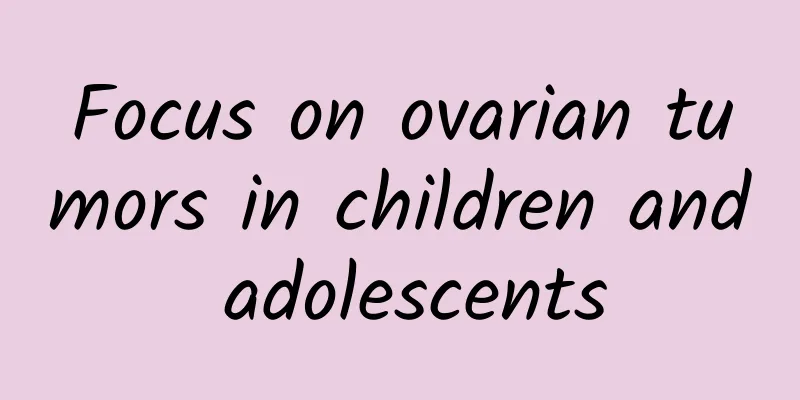Focus on ovarian tumors in children and adolescents

|
13-year-old Yanyan is a cute and well-behaved junior high school student. She has been healthy since she was young and rarely suffers from headaches or fevers. However, in the past six months, Yanyan suddenly found that she had gained weight. Some of the pants that she could easily put on before could not be buttoned. Yanyan's mother initially thought that she ate too much, but she didn't expect that she would grow bigger and bigger. Her mother had to take her to the hospital for a check-up. After a gynecological B-ultrasound, it was found that there was a pelvic mass of about 15 cm hidden in her small body. The subsequent MRI examination suspected that the pelvic mass was of ovarian origin and was likely to be malignant! Seeing this, everyone is probably as surprised and confused as Yanyan's mother. Ovarian tumors are generally not easy to get when you are old. How could a small child have such a large tumor on the ovary? In recent years, the incidence of gynecological malignant tumors has been showing a trend of becoming younger, and the incidence of ovarian malignant tumors in children and adolescents has increased year by year, which has increasingly attracted the attention of gynecologists. Today we will talk about ovarian malignant tumors in children and adolescents in the form of a question and answer. Q: What is ovarian malignancy in children and adolescents? A: Ovarian malignancies in children and adolescents refer to ovarian malignancies occurring in children and adolescents under the age of 19 (as defined by WHO). Q: Is the incidence of ovarian malignant tumors high in children and adolescents? A: Although the incidence rate is not high, accounting for about 1% of all malignant tumors in children and adolescents, it tends to increase year by year during adolescence. Among children aged ≤9 years, about 0.102/100,000 suffer from ovarian malignant tumors each year. The incidence rate in the 10-19 age group increases 10 times to 1.072/100,000. Q: What are the symptoms? A: The symptoms of ovarian malignancies in children and adolescents are atypical, and there are usually no obvious specific symptoms in the early stages of the disease. Abdominal pain is the most common symptom, and other symptoms include abdominal mass, precocious puberty, and gradually increasing abdominal circumference. Some adolescents seek medical attention for abdominal pain accompanied by nausea and vomiting, which is often mistaken for appendicitis. Q: What are the types of pathology? A: Malignant ovarian tumors in children and adolescents are mainly germ cell tumors, accounting for about 70% of all adolescent ovarian tumors. Other types include epithelial tumors and sex cord-stromal tumors. Germ cell tumors can be divided into teratoma, dysgerminoma, yolk sac tumor, embryonal carcinoma, choriocarcinoma and other pathological types. Q:Are all ovarian tumors in teenagers malignant? Not always, but the probability of finding ovarian tumors as malignant tumors in children is higher. In addition, early puberty and gradually increasing abdominal circumference also indicate a high possibility of ovarian malignancy. Q: Is it usually in the late stage when it is discovered? A: Unlike malignant ovarian tumors in adults, malignant ovarian tumors in adolescents are usually discovered in the early stages and have a better prognosis. Q: How should it be treated? A: Surgery is the first choice, supplemented by postoperative chemotherapy. Unlike the widespread dissemination and metastasis of adult ovarian malignancies, adolescent ovarian tumors are mostly germ cell tumors with a more limited distribution. Lymph node resection, peritoneal surface biopsy, and omentectomy are necessary steps in the surgical staging of adult ovarian malignancies, but these steps are not necessary for adolescent germ cell tumors unless there is a tumor visible to the naked eye. Q: Can I preserve my fertility? A: Given that ovarian tumors in children and adolescents are mostly histologically malignant germ cell tumors, are more common in unilateral and early stages, and are more sensitive to chemotherapy, standardized and systematic treatment and long-term close follow-up make fertility-preserving surgical treatment completely feasible. In fact, when formulating surgical plans for these young patients, gynecologists must consider the preservation of ovarian function and fertility. Q: Will the surgery damage ovarian function? A: Wedge resection of the ovaries during surgery will damage ovarian function and reduce fertility to a certain extent. Therefore, we should try to minimize damage to the ovarian cortex during surgery and avoid using energy devices. Q: Will chemotherapy damage ovarian function? A: Chemotherapy can also damage ovarian function. In mild cases, it affects the growth and maturation of follicles. In severe cases, it can reduce the reserve of follicles at all levels of the ovaries, leading to premature ovarian failure, affecting the patient's chances of pregnancy in the reproductive period, and increasing the occurrence of adverse pregnancy outcomes. Q: How to protect ovarian function and reduce the toxic side effects of chemotherapy? A: During the treatment, we should try to choose chemotherapy drugs that cause less damage to the ovaries, accurately calculate the cumulative dose of the drugs, pay attention to the toxic and side effects of various chemotherapy drugs, and closely monitor ovarian function. In addition, the use of gonadotropin-releasing hormone agonists (GnRHa) and ovarian tissue freezing and transplantation can prevent the toxic and side effects of chemotherapy on the ovaries to a certain extent. Finally, I hope that this popular science article can serve as a wake-up call to all parents. They should pay more attention to their children's conditions. If they have unexplained abdominal pain, bloating, or increased waist circumference, they should be alert to the possibility of adolescent ovarian tumors and take their children to the hospital for examination in time. Author: Di Wen, Renji Hospital, Shanghai Jiao Tong University School of Medicine About the Author Diwen Doctor of Medicine, Chief Physician, Professor, and Doctoral Supervisor. Vice President and Director of the Department of Obstetrics and Gynecology of Renji Hospital Affiliated to Shanghai Jiaotong University School of Medicine, Director of the Shanghai Key Laboratory of Gynecological Oncology. Vice Chairman of the Obstetrics and Gynecology Branch of the Chinese Medical Association, Vice President of the Obstetrics and Gynecology Branch of the Chinese Medical Doctor Association, President of the Obstetrics and Gynecology Branch of the Shanghai Medical Doctor Association, and Chairman of the Shanghai Maternal and Child Safety Expert Committee. Expertise: diagnosis and treatment of gynecological malignancies and pregnancy complicated with immune system diseases. Special outpatient clinic time: Thursday morning Funded by Shanghai Science and Technology Commission's Science Popularization Project (Project No.: 20DZ2311100) |
<<: Beware of "menstrual disorders" which are not gynecological diseases
>>: I just finished treatment for gynecological cancer, but I am worried about recurrence...
Recommend
What to do if you have ovarian cysts and stomach pain
The ovaries are very important organs for women, ...
Revealing the real culprit of women's private itching
1. The most common local cause is increased leuco...
What are the benefits and functions of black bean sprouts? Detailed introduction of black bean sprouts
Black bean sprouts are tender and nutritious. The...
I feel bad after giving birth and always want to cry
In addition to some physical conditions, some pre...
Can women with vulvar leukoplakia be cured?
History of gynecological diseases: There are dise...
Belly shape of a girl born at 37 weeks of pregnancy
At 37 weeks of pregnancy, women will clearly feel...
What does it mean when a pregnancy test shows negative
The use of pregnancy test sticks can detect wheth...
The significance of estradiol in pregnancy tests
Estradiol is a hormone. It is very important to c...
[Creative Cultivation Program] Gut flora and emotions: Do you believe it? Your emotions are being controlled by your gut flora
Author: Zhao Bei Mental illnesses that threaten o...
The dangers of sitting for a long time after childbirth
Confinement after childbirth is a widely spread c...
Can women eat pig blood during menstruation?
There are many foods that women need to avoid dur...
Can I eat yogurt when I have my period?
Women's body resistance is very low during me...
Can I smoke while breastfeeding?
As society is becoming more and more open, smokin...
What are the reasons for poor follicle growth?
Poor follicle growth means that in the late stage...
Little menstrual flow and no period at night
Because every woman has a different physical cons...









